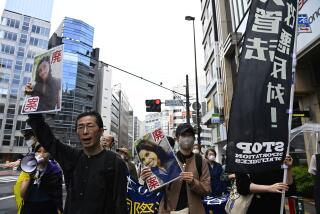Japan’s Housing: Pricey, Chilly and Toilet-Poor : Lifestyle: Items of comfort and convenience taken for granted in the United States are woefully lacking in island nation.
- Share via
TOKYO — As biting winter winds swept through teeming shopping districts, appliance and department stores stepped up promotions of a hot seasonal seller--kerosene-burning camp stoves.
The stoves, used in the United States mainly by hikers and ice fishermen, sell by the millions here each winter, but not for camping in the snow; people here need them to keep their houses warm.
Because of high energy costs and aging housing stock, fewer than 20% of Japanese homes have central heating, according to the housing industry. Consequently, people use all sorts of makeshift devices--camp stoves, electric blankets, electric carpets, even heated tables--to provide islands of warmth inside chilly houses.
Central heating is not the only aspect of modern living that most Japanese do without. Because the country has been slow to invest in sewage systems, only 42% of Japanese homes have flush toilets, according to the Construction Ministry.
A nation shivering through winter in houses that lack modern heat and plumbing hardly fits the world’s image of Japan as an economic superpower. This contrast demonstrates the looming gap between the country’s national wealth and the people’s standard of living.
As measured by gross national product, Japan is the world’s second-richest country, trailing only the United States. In per capita GNP, it has passed the United States to rank first, and it is the home of the world’s biggest banks and business combines.
And yet, most Japanese routinely accept housing conditions that would spark rent strikes and lawsuits almost anywhere in America.
The Japanese pay more for housing and get less for their money than residents of other developed countries. The average house price nationwide is 5.7 times the average annual income. In the Tokyo area, where a quarter of the population lives, a house costs 8.7 times annual income. The comparable U.S. figure is 3.4 times annual income.
Most Japanese, for their outlay, live in houses that are tiny by American standards. A narrow two-bedroom house for a family of four is common, with each bedroom about the size of an American walk-in closet. In the average Japanese house, there are about 250 square feet per person. The U.S. average is about 600 square feet per person.
During the winter months, though, the number of rooms in the house is irrelevant to many Japanese. Families here tend to heat only one room of the house at a time. As a result, it is common for all the members of a family to spend winter evenings seated together around a table in a single room.
The standard locale for these evenings of family togetherness is the kotatsu, or “heated table”--a long, low table that has an electric heating element underneath and a feather comforter around the sides to keep the heat in.
On a bitter evening in February, for example, at the home of Masatoshi Shibata, a farmer in northern Akita Province in the heart of Japan’s snow belt, the family had dinner at the kotatsu and then everyone remained at the table until bedtime. The children did homework. The adults read, sewed or watched television, while sipping hot tea or hot rice wine.
Sitting around the heated table is so cozy that family members often don’t want to get up--even for compelling reasons. A cliche on TV comedy shows here is the scene in which family members seated around the kotatsu start grimacing and squirming because they’re reluctant to get up and go to the frosty bathroom.
“The basic concept of a heating system in Japan is just to heat the person, not the whole house,” said Shigero Yamada, of a government-sponsored housing think tank called Better Living.
More to Read
Sign up for Essential California
The most important California stories and recommendations in your inbox every morning.
You may occasionally receive promotional content from the Los Angeles Times.













